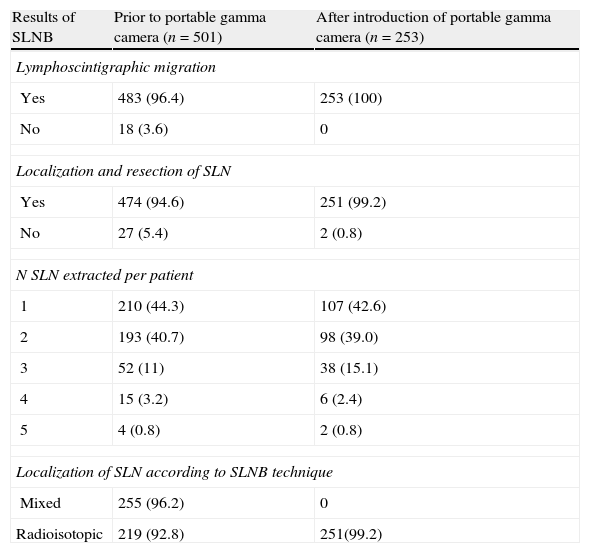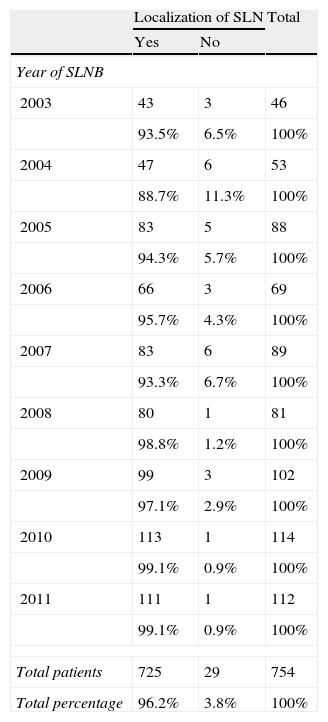To define the sentinel node identification rate in breast cancer, the chronological evolution of this parameter and the influence of the introduction of a portable gamma camera.
Material and methodsA retrospective study was conducted using a prospective database of 754 patients who had undergone a sentinel lymph node biopsy between January 2003 and December 2011. The technique was mixed in the starting period and subsequently was performed with radiotracer intra-peritumorally administered the day before of the surgery. Until October 2009, excision of the sentinel node was guided by a probe. After that date, a portable gamma camera was introduced for intrasurgical detection.
ResultsThe SN was biopsied in 725 out of the 754 patients studied. The resulting technique global effectiveness was 96.2%. In accordance with the year of the surgical intervention, the identification percentage was 93.5% in 2003, 88.7% in 2004, 94.3% in 2005, 95.7% in 2006, 93.3% in 2007, 98.8% in 2008, 97.1% in 2009 and 99.1% in 2010 and 2011. There was a significant difference in the proportion of identification before and after the incorporation of the portable gamma camera of 4.6% (95% CI of the difference 2–7.2%, P=0.0037).
ConclusionsThe percentage of global identification exceeds the recommended level following the current guidelines. Chronologically, the improvement for this parameter during the study period has been observed. These data suggest that the incorporation of a portable gamma camera had an important role.
Determinar el porcentaje de identificación global del ganglio centinela (GC) en el cáncer de mama, la evolución cronológica de este parámetro y la influencia de la introducción de una gammacámara portátil.
Material y métodosEstudio retrospectivo a partir de una base de datos prospectiva de 754 pacientes a las que se realizó biopsia selectiva del GC de forma consecutiva entre enero de 2003 y diciembre de 2011. La técnica fue mixta en periodo inicial y posteriormente con radiotrazador administrado intra-peritumoralmente. Hasta octubre de 2009 la exéresis del GC fue guiada por sonda y a partir de esta fecha se introdujo una gammacámara portátil para la detección intraoperatoria.
ResultadosSe ha biopsiado el GC en 725 de 754 pacientes, siendo por tanto la eficacia global del 96,2%. Según el año de intervención quirúrgica los porcentajes de identificación han sido del 93,5% en 2003, del 88,7% en 2004, del 94,3% en 2005, del 95,7% en 2006, del 93,3% en 2007, del 98,8% en 2008, del 97,1% en 2009 y del 99,1% en 2010 y 2011. Existe una diferencia de proporciones entre el porcentaje de identificación antes y después de la incorporación de la gammacámara portátil del 4,6% que es estadísticamente significativa (IC 95% de la diferencia 2-7,2% con una p asociada de 0,0037).
ConclusionesEl porcentaje de identificación global se halla por encima del nivel recomendado por las directrices actuales. Cronológicamente se constata elevación de este parámetro a lo largo del periodo estudiado. Los datos apuntan a que la incorporación de una gammacámara portátil ha tenido un papel en ello.
Article
If you experience access problems, you can contact the SEMNIM Technical Secretariat by email at secretaria.tecnica@semnim.es or by phone at +34 619 594 780.

Revista Española de Medicina Nuclear e Imagen Molecular (English Edition)











